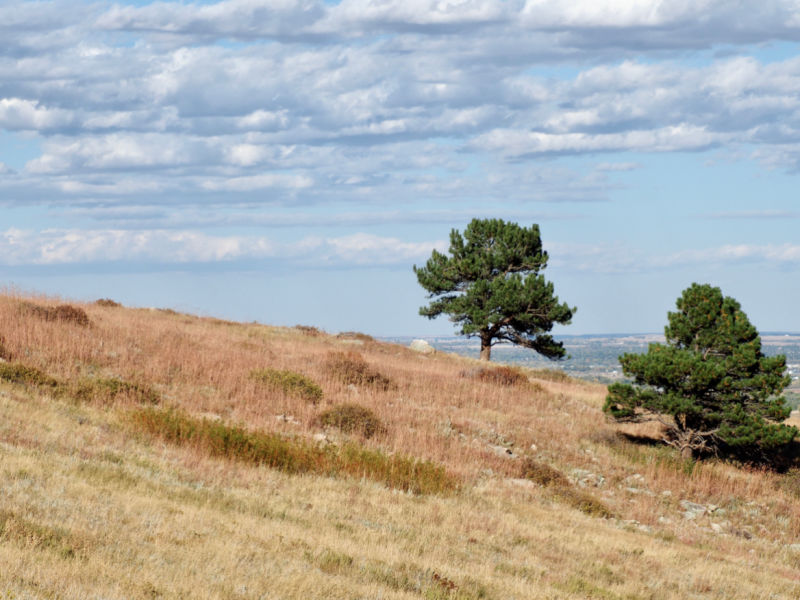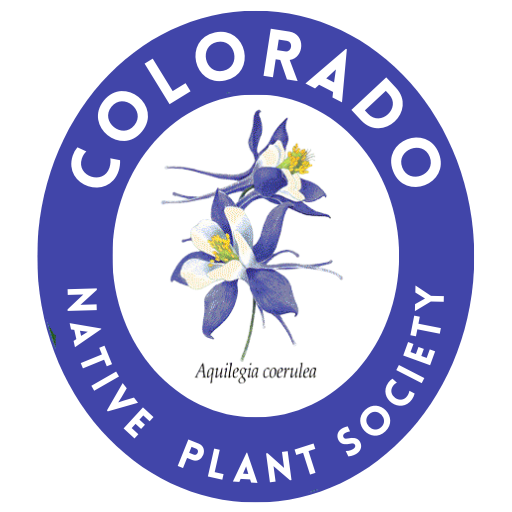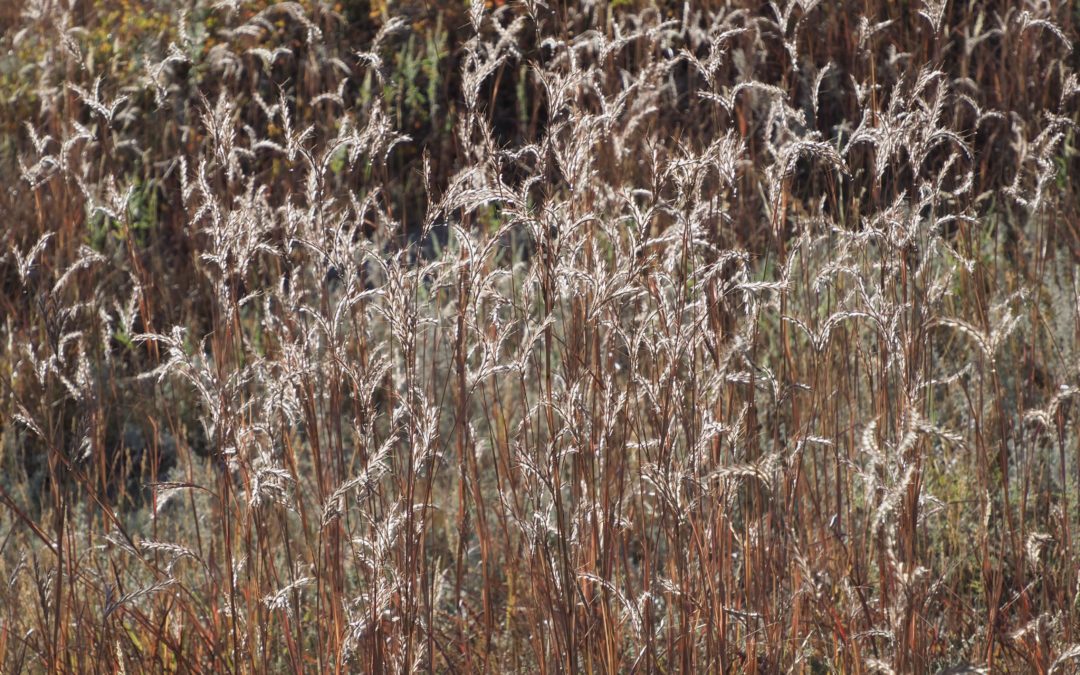Perhaps you missed the flowers, they’re pretty tiny, but during the rich light of a late sunny afternoon, you can’t miss the brilliant shine of the seed heads of our two native grasses, Big bluestem and Little bluestem. So alike, yet so different, and each is from a different genus. Both are part of the ‘Big Four,’ the most important of the tall grassprairie grasses, and have important roles to play in the ecosystem, past, present, and future. Learning to tell them apart has been a fun project for me.

Big bluestem seed heads translucent in afternoon light.
The common name, bluestem, comes from the bluish cast to the early spring growth. Even in early spring you can tell big blue from little blue by gently pulling the culms, or stems, apart at the plant’s base. Big blue will have fine hairs where the leaf joins the culm. Now there’s a fine trivia fact for you! These hairs tend to become less apparent as the season progresses, but may still be slightly present even in winter.

Fine hairs at base are a sure tell – it’s Big bluestem.
By the time fall comes, both Big and Little bluestem turn similar colors of bronze-brown, copper, and red. Often a glance across a field will tell you that one or the other is present, and when you get closer, you will know which it is by the seed heads.

Big and Little bluestem form swathes of red across the fields in fall.
Big bluestem, Andropogon gerardii, has another common name: turkey foot. Its seed heads form in spikelets, often in threes, but anywhere from two to seven, which resemble a turkey’s foot. These spikelets are more coarse and less ‘fuzzy’ in appearance than the seed heads of Little bluestem.

Another name for Big bluestem, Andropogon gerardii, is Turkey foot.
Big blue is both highly palatable and highly nutritious for grazing animals. Like Little blue, it is also host to quite a number of our beneficial insects including the many of our Hesperiidae, or skippers. During the growing season, many species of butterfly larvae (caterpillars) feed and rest on the blades of native grasses. Both blues provide important overwintering habitat for insects as well. Native bumble bee queens nest in their bases. Our beloved – and disappearing – firefly needs the shelter of these grasses during the day.
Little bluestem, Schizachyrium scoparium – okay, let’s pause for a minute. You’re a plant person, you want speak up like a pro when the convo turns to grasses right? Well, first of all, there really is no absolute ‘right’ way. There are regional differences in pronunciation, and we don’t really know how the ancient Romans and Greeks spoke the sounds. But if you can get your mind around this version, you will be understood by a plant person anywhere. The cadence is more important than the phonetic nuances.
Shiz ah KEER ee um sco PAR ree um. So there. It took me about three years. Here’s another little hint for pronunciation help. Several places on the web have audio prompts for pronunciation of botanical names, the Missouri Botanical Garden is a good one.
So the seed heads of Little blue are more fine, seem to have a more fluffy appearance, the spikelets, (flower clusters) form in pairs along the spike and spread out as they mature. Each seed has an awn, a hair like structure that is usually attached at ninety degree angle. The mature seeds are greatly favored by small birds in the winter months, and the plant is able to stay upright even in snow so it makes an excellent nesting and resting place for them all year round.

Seed heads of Little bluestem, Schizachyrium scoparium.
The deep roots of our native grasses, often penetrating farther down into the soil than the plant reaches upward above ground, are extremely valuable to soil health. The massive fibrous portion of deep roots not only helps bind the soil and prevent erosion, but each year about one third of the root system is sloughed off to be replaced by new growth in the spring. The decomposing roots contribute to organic content, increasing soil fertility.
One last interesting fact. The ‘Big Four’ most important of the tallgrass prairie grasses, in addition to Big bluestem and Little bluestem, included Indiangrass, (Sorgastrum nutans), and Switchgrass, (Panicum virgatum). Together these grasses were responsible for forming the sod that was first used by Native Americans to build Earth Lodges. The sod was so thick it could be cut up and used as bricks were, for stacking together to make walls. There were few trees on the prairies so necessity was the mother of invention. Later, American Homesteaders copied these example to form their sod houses.
Native grasses are still important today for all they contribute to our sustainable future. Big bluestem and Little bluestem, thank you for your service!!
~Photos by author
Sue Dingwell
Media Committee


Thank you Sue, for a very helpful and interesting discussion of the two Bluestem species.
Most welcome, thanks for your comment!
Great comments on the importance of the 4 prairie grasses. Do you give talks to area residents?
Paula, thanks for your comment and yes, I would consider giving a talk for select audiences, my experience in Colorado
is limited to the past three years.